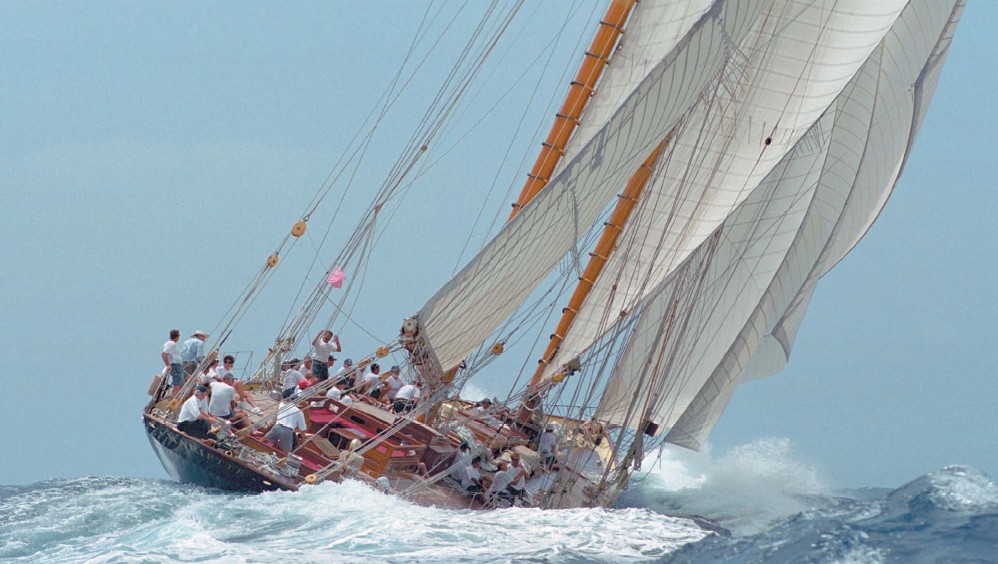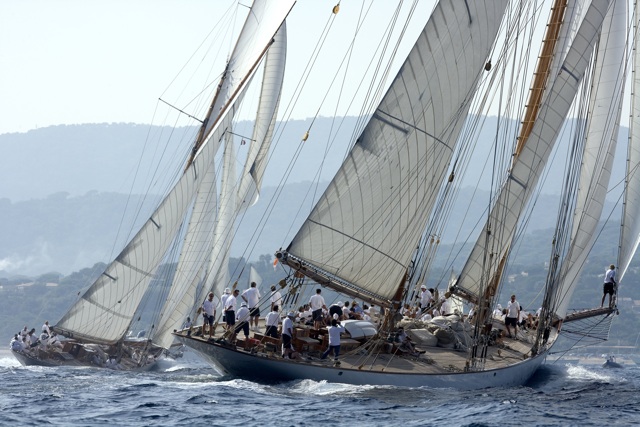It is already being heralded as one of those rare ‘must see’ occasions when four of the most beautiful Big Class classic yachts in the world will be racing together off Cowes, Isle of Wight, between 5th – 10th July, as they compete to win the inaugural Westward Cup Regatta.
The Regatta is being organised by three of the most prestigious yacht clubs in the world, namely the Royal Yacht Squadron (RYS) and two partner Clubs, the New York Yacht Club (NYYC) and Yacht Club de Monaco (YCM). It is very much hoped that this event will mark the revival of and interest in Big Class yacht racing in the Solent and around the world over the coming years.
Initiated by the owner of one of these Big Class yachts, Eleonora, a replica of Westward, to commemorate the 100th anniversary of Westward’s launch, the organisers have set out to replicate a style, class and regatta atmosphere matching the period when Westward and the Big Class yachts all raced in Cowes, the birthplace of such elegant racing during the 1920s and 30s.
A number of Big Class yacht owners have been personally invited to race against each other over 40-50 mile courses similar to those that these yachts or their predecessors will have sailed in those golden days of Big Class racing. It is still very much hoped that the 15 metre William Fife-designed Tuiga, built in 1909, will also make it to the start line.
Depending on the weather conditions, the schedule may include a race around the Isle of Wight. With the advent of 21st century tracking technology starting to introduce yacht racing to a far larger and global audience, armchair enthusiasts will be able to follow the yachts’ progress online as they sail their courses with each being fitted with a Yellowbrick Tracking device.
Safety is paramount
With the ‘traffic’ conditions in the Solent having changed quite considerably since those early days of racing in somewhat quieter waters, safety is paramount. There will be a large exclusion zone around the Royal Yacht Squadron start line, a safety officer on board each of the competing yachts as well as a support RIB for each of the yachts. Those safety measures put in place will greatly benefit from the wealth of race organisation experience available at the Royal Yacht Squadron, including its highly successful running of the 2001 America’s Cup Jubilee.
In terms of the racing programme, four days of racing and a rest day have been scheduled and the sailing instructions will adhere as closely as possible to those recently agreed by “La Belle Classe”, an association of classic yachts initiated by the YCM. There is also a superb social programme lined up for the owners, their guests, captains and crew.
The Event is also being supported by Boat International Media as a media partner.
Spectating
This exquisite fleet of Big Class classic yachts will, generally speaking, be racing within the confines of the Solent and everyone can watch the starts and finishes in Cowes for the duration of the Westward Cup Regatta. The key vantage points are along Cowes Parade and below the Castle parapet, and along Princes Green to the West.
It is incredible that these huge yachts carry a racing crew of up to 40 and can take up to half an hour to put up and another half an hour to take down their sails.
Owing to the amount of room these boats need to manoeuvre, there will strict on-water guidelines in place for all spectator and pleasure craft and safety boats patrolling.
The Westward Cup and regatta trophies
An English Silversmith, Mr Richard Parsons, has been commissioned to design and build the Westward Cup, a perpetual trophy being crafted on behalf of the owner of Eleonora, in celebration of the centenary of Westward’s launch in July 1910. The Cup will be similar in design to the Cup that Westward won when she was racing in the Solent and will be presented to the overall winner of the inaugural Westward Cup Regatta in July 2010. There are keepsake trophies for the overall winner, and second and third overall.
As each of the four race days is being sponsored by one of each of the participating yacht clubs and one by Boat International Media, there are also Club trophies and keepsake trophies to be presented.
The competitors
The organisers confirm that the following four Big Class yachts will be on this historic of start lines:
Eleonora – Using original drawings from the Herreshoff Manufacturing Company which built Westward, and from close study of contemporary photographs, Eleonora is an exact replica of her famous antecedent. Built in Holland at Van der Graaf Shipyard in steel, she was launched 90 years to the day of Westward’s launch, on 31 March 2000. Since then she has been a regular and successful competitor on the Classic yacht circuit. Superbly fitted out in mahogany, with period details, she has two doubles and one twin stateroom and a full-beam owner’s stateroom aft.
LOA 49.5m (160ft)
LWL 29.3m (96ft 1in)
Beam 8.2m (27ft 1in)
Draught 5.2m (17ft 1in)
Sail area 1,115m2 (12,000sqft)
Displacement 214 tons
Britannia - The Kings’ (she was owned by three British sovereigns: Edward VII, George V and briefly Edward VIII) Britannia is undoubtedly the most famous of the Big Class yachts winning, in a career that began on the Clyde in 1893 until her scuttling off St Catherine’s in 1936, 360 prizes (I, II, III) in 635 races – a record that can never be equalled. Her wooden – as opposed to the original that was composite, wood/steel framed – replica was built in Russia near Archangelsk over a period of 12 years, her launch mired in legal battles with the yard. Her owner, Norwegian Sigurd Coates, is to base her in Cowes and the Westward Cup Regatta will be her first outing.
LOA 37m (121ft 6in)
LWL 26.7m (87ft 9in)
Beam 7.1m (23ft 3in)
Draught 4.6m (15ft 1in)
Sail area (original rig) 930m2 (10,000 sqft)
Displacement 154 tons
Mariquita - Mariquita (Spanish for ‘ladybird’) is the sole survivor of the 19 Metre Class, whose racing career flourished for two brief seasons before the First World War. Designed and built by William Fife at his Fairlie yard in 1911, Mariquita along with Corona, Norada (Nicholson) and Octavia thrilled the racing public from Kiel to the Clyde, where they arrived having braved a North Sea gale. After the collapse of the class, Mariquita went cruising and eventually, minus her keel and rig, became a houseboat at Pin Mill, Suffolk. She was rediscovered in 1991 by William Collier, and restored on the Hamble by Fairlie Restorations in 2004. A winner at Imperia she attended the Fife gathering on the Clyde in 2008.
LOA 38.1m (125ft)
LWL 20.1m (66ft)
Beam 5.3m (17ft 4in)
Draught 3.7m (12ft)
Sail area 585m2 (6,260sqft)
Displacement 79 tons
Mariette - Built in 1915, Mariette was designed by Nathanael Greene Herreshoff for J Frederick Brown of Boston, a successful wool merchant, who raced and cruised her along the North and South Shores of Boston from 1916 to 1927. Renamed Cleopatra’s Barge under Francis K Crowninshield’s ownership, she was requisitioned by the American Navy during the war and declined thereafter. Restored at Cantiere Navale Beconcini in1995, she is owned by Thomas Perkins, of San Francisco, who re-rigged her as original. She returned to New England waters and competed in the New York Yacht Club's Atlantic Challenge. She is a regular and successful competitor in Mediterranean classic events.
LOA 42.06m (138ft)
LWL 24.38m (80ft)
Beam 7.19m (23ft 7in)
Draught 4.8m (15ft 9in)
Sail area 750m2 (8,060sqft)
Displacement 165 tons


About The Author
Afloat.ie Team
Afloat.ie is Ireland's dedicated marine journalism team.
Have you got a story for our reporters? Email us here.
We've got a favour to ask
More people are reading Afloat.ie than ever thanks to the power of the internet but we're in stormy seas because advertising revenues across the media are falling fast. Unlike many news sites, we haven’t put up a paywall because we want to keep our marine journalism open.
Afloat.ie is Ireland's only full–time marine journalism team and it takes time, money and hard work to produce our content.
So you can see why we need to ask for your help.
If everyone chipped in, we can enhance our coverage and our future would be more secure. You can help us through a small donation. Thank you.































































